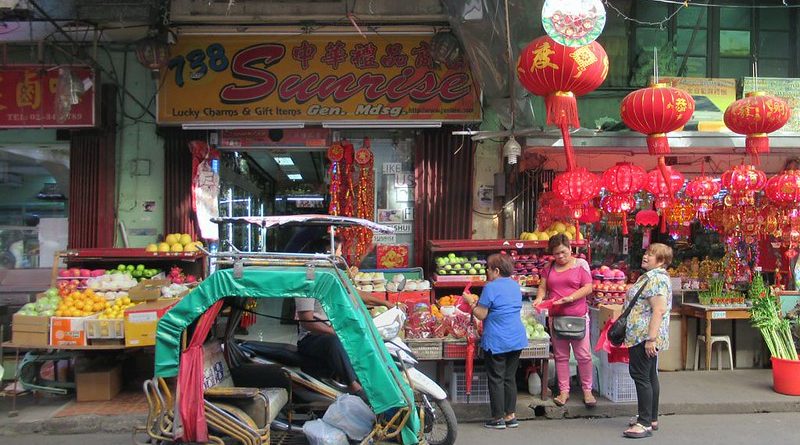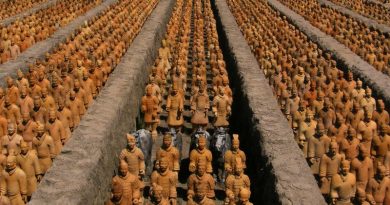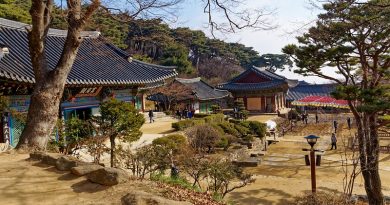Chinatowns Of The World
Chinatowns are located all around the world, from the Americas to Europe as well as Africa, Australia and Asia. These areas are historically known as any ethnic enclave of expatriate Chinese, Macanese, Taiwanese and Hong Kongese.

Chinatown and Spring Blossoms Vancouver Island. Photo credit: Nick Kenrick.
It’s a district of any non-Chinese town, especially a city or seaport, where the population is primarily of Chinese origin. However, this definition has been challenged because some of these “Chinatowns” include pan-Asian, which could signify they might also be regarded as Korea town or Little India.
Binondo -The World’s First Chinatown
The oldest Chinatown in the world, established in 1594, belongs to Binondo, an enclave in Manila mainly populated by ethnic Chinese living in the Philippines. Historically, this was where the Spanish permitted converted sangleys, which is an archaic term used in the Philippines to describe and classify a person of pure Chinese ancestry, while mestizo de sangley was used to refer to a person of mixed Chinese and indigenous ancestry.
Binodo is located across the Pasig River from Intramuros. Binodo has symbolised a small Chinese town and is classified as the local “China Town.” The district is the center of commerce and trade for all types of businesses run by Filipino-Chinese merchants. Binodo was created by Spanish Govevernor, Luis Perez Dasmarinas, as a permanent settlement for Chinese immigrants who converted to Catholocism. The Spanish gave a land grant for Binodo to a group of Chinese merchants and artisans infinitely, tax-free and with limited self-governing privileges. If Chinese immigrants did not convert to Catholocism, they were expelled or killed. This is also the reason the Chinese mestizo population of Binodo grew swiftly.

Today, the Manila Chinatown is a blend of Chinese, Fillipino and Spanish cultures. Besides eating in Chinatown, the turnover of business here is most likely greater than anywhere else in the Philippines.
Chinatown Beginnings
In Southeast Asia, trading centers were primarily inhabited by Chinese men and their native spouses, which had long existed here. With the signing of the Treaty of Peking in 1860, it opened the border for free movement and emigration to other parts of the world increased rapidly in the 1860s. Many of the first emigrants came predominately from the coastal provinces of Guangdong and Fujian in southeastern China, where Cantonese, Hakka, Teochew and Hokkien were mainly spoken. As conditions in China have improved in recent decades, many Chinatowns have lost their initial mission, which was to provide a transitional place into a new culture. As a great portion of migration gradually decreased, the smaller Chinatowns have slowly decomposed, many times to the point of simply remaining a historical site and no longer serving as a place for ethnic territories.
Besides the Binodo Chinatown in Manila, there are other Asian Chinatowns that have a long history, which include Nagasaki, Japan and Hoi An in central Vietnam. These existed in 1600. There is also Glodok, the Chinese quarter of Jakarta, Indonesia, which originated in 1740 as well as the Chinatown centered on Yaowarat Road in Bangkok, Thailand, which was established in 1782 and coincided with the founding of the city as well.
Chinese Migration
Millions of Chinese left their home country in the past to go and live abroad. Many of them set off to other countries out of economic necessity. In earlier centuries, the Chinese abroad were treated badly and seen as cheap workers. They had jobs in farming, as cooks on ships or as harbor workers. In the US, thousands of Chinese assisted in building the railroads that span the continent today. However, in previous times, the United States and other countries limited the number of Chinese who could enter the country.

Chinatown – Clay Street, San Francisco. Photo credit: Moments For Zen.
In the mid 1840s, China experienced a chain of natural disasters across the country. These resulted in famine, peasant uprisings and rebellions. At the same time, news spread to the Chinese of gold and opportunity in America. Many Chinese took this opportunity to migrate to the United States.
In 1850, when the Chinese settled in San Francisco, their work ethic was initially acknowledged by Mayor John W. Geary who held a ceremony for who he referred to as the “China Boys.” They had superior farm laboring skills and developed laundry businesses. They were also skilled in the restaurant business, fishing and shrimping industries as well as leather goods manufacturing. However, as soon as these new business flourished, they weren’t always welcomed with open arms and in times of a weak economy, the Chinese labor force became a threat to mainstream society. They faced problems such as racial discrimination and repressive legislation, which inevitably drove the Chinese from the gold mines to a sanctuary where they were embraced for who they were. This neighborhood became known as Chinatown.
The Chinese were also denied several rights. They were prohibited by law to testify in court, to own property, to vote, to have families join them and to marry non-Chinese and to work in institutional agencies. In spite of these odds, the Chinese managed to persevere and create a vibrant, flourishing community of their own in what is known as “Chinatown.”
Notable Chinatowns Of The World
New York, New York
Due to the job slump in San Francisco, many Chinese were driven east to New York. Faced with increasing racial discrimination and new laws, which prevented participation in many occupations on the West Coast, some Chinese immigrants moved to the East Coast cities in search of employment. Early businesses in these cities included hand laundries and restaurants. Chinatown started on Mott, Park (now Mosco), Pell, and Doyers Streets, east of the notorious Five Points district. By 1870, there was a Chinese population of 200. By the time the Chinese Exclusion Act of 1882 was passed, the population was up to 2,000 residents.

New York City Street Scene Chinatown. Photo credit: Steven Pisano.
By 1900, there were 7,000 Chinese residents, but fewer than 200 Chinese women. New York is known as America’s largest Chinese community of over 150,000 people. Due to New York’s cramped nature, the Chinese were needed for their laundering skills. The first Chinese person noted to permanently immigrate here was Ah Ken in the 1840s; As a Cantonese businessman, Ah Ken eventually founded a successful cigar store on Park Row. Later immigrants would similarly find work as “cigar men” or carrying billboards, and Ah Ken’s particular success encouraged cigar makers William Longford, John Occoo, and John Ava to also carry out their trade in Chinatown, eventually forming a monopoly on the cigar trade. It has been speculated that it may have been Ah Ken who kept a small boarding house on lower Mott Street and rented out bunks to the first Chinese immigrants to arrive in Chinatown. It was with the profits he earned as a landlord, earning an average of $100 a month, that he was able to open his Park Row smoke shop around which modern-day Chinatown would grow.
By 1880, the growing enclave in the Five Points slums on the southeast side of New York was home to between 200 and 1,100 Chinese. A few members of a group of Chinese illegally smuggled into New Jersey in the late 1870s to work in a hand laundry and soon made the move to New York, sparking an explosion of Chinese hand laundries.
The Chinese Exclusion Act, from 1882 to 1943, was the only non-wartime federal law, which excluded a community based on nationality. It was a reaction to rising anti-Chinese sentiment. This resentment was largely a result of the willingness of the Chinese to work for much less money under a great deal of worse conditions than the white laborers and the unwillingness to “assimilate properly”. The law forbade naturalization by any Chinese person already in the United States; bars the immigration of any Chinese not given a special work permit deeming him a merchant, student, or diplomat; and, most horrifically, prohibits the immigration of the wives and children of Chinese laborers living in the United States. The Exclusion Act grew more and more restrictive over the next decades, and was finally lifted during World War II, only when an extreme racist law against a wartime ally became a flawed option.
Today, Chinatown in New York, located on the lower east side in Manhattan, is the largest Chinatown in the United States. It also contains the largest concentration of Chinese in the western hemisphere. By the 1980s, it had surpassed San Francisco. However, in the last several years, it has been trumped by the lesser-known but larger community in nearby Flushing, Queens, New York.
Lima, Peru
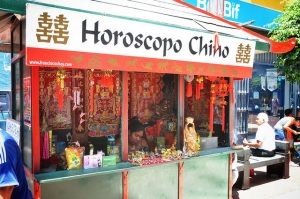
Horoscopo Chino Lima, Peru. Photo credit: Sebastien A.
Lima, Peru boasts a Chinatown, often referred to locally as Barrio chino. It is centered on two blocks -the seventh and eighth- of Jirón Ucayali in downtown, a stretch almost unanimously referred to as Calle Capón, a name gained during the Spanish Colonial period as it was the location of the market for castrated pigs. In the 1850s, Chinese immigrants started to cluster in the area around the Central Market, then called La Concepción. The consolidation of an ethnic Chinese neighborhood was spurred by the presence, from the 1860s, of large commercial houses established by Chinese import companies from Hong Kong and California, such as the Wing Fat Co., the Wo Chong Co., or the Wing On Chong Co.
Within a brief time Chinese immigrants had established a number of Benevolent Societies and temples, often according to place of origin. For example, the Ku Kong Chao Association was established in 1868 by immigrants from rural Guangdong, the Pun Yui Society by Cantonese immigrants in 1887, and the Tungshin Society in 1898 by Hakka immigrants. The Chinese Central Benevolent Society, or Tonghui Chongkoc, was formed in 1882 to provide members with myriad services from legal counseling to burial insurance, and the establishment of a Chinese school.
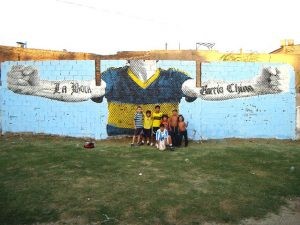
Potrero Barrio Chino. Photo credit: Run Dont Walk.
Although there was a period of looting from Chilean military during the War of the Pacific that left the area in economic disarray, there were some large businesses that managed to survive. The neighborhood became a target of critiques by the Lima elites intent on cleaning up the city and of mobs incited by political candidates and racist stereotypes. In 1909 the government demolished part of the quarter, and the neighborhood was again attacked during the labor riots of 1918.
The 20th Century brought about a condensed Chinatown but it still retained its distinctive character. The overcrowding made this an ideal location for pickpockets and cut purses. Since the 1970s, along with this physical renovation, the rescinding of the ban on Chinese immigration contributed to a demographic and cultural renewal of the barrio chino as well. Like Chinatowns in other countries, Lima’s Chinatown is also a source of Chinese ingredients and a focal point of Chinese cuisine. There are over 6000 Chinese restaurants in Lima, called “chifas”, and some of the most prominent and respected of these are located in Chinatown.
Havana, Cuba
Havana’s Chinatown is Latin America’s oldest Chinatown. At one point, it was even the largest in Latin America. Due to the diminishing African slave trade after England’s abolition of slavery in 1833 and the decline of slavery in the United States, a labor shortage in Cuba led plantation owners to seek out workers elsewhere.
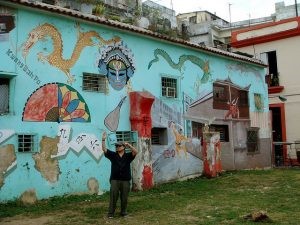
Havana’s Chinatown. Photo credit: Andrea Williams.
Chinese immigration to Cuba began in 1847 when Chinese (Cantonese and Hakka) contract workers were brought to work in the sugar fields, bringing the religion of Buddhism with them. They were often referred to as coolies, a label that was used to refer to a person from Asia, particularly if they were from Southern China, the Indian subcontinent, the Philippines or Indonesia. Hundreds of thousands of Chinese workers were brought in from China, Hong Kong, Macau, and Taiwan during the following decades to replace and sometimes work alongside African slaves.
The Chinese had strong reasons for wanting to leave China behind. China emerged as the labor source following deep social turmoil after the First and Second Opium Wars. Changes in the farming system, a spike in population growth, political dissatisfaction, natural disasters, banditry, and ethnic friction, (especially in southern China) led many farmers and peasants to leave China and look for work abroad.
About 120,000 Chinese male coolies entered Cuba under contract for eight years. Most were not married, but there was frequent sexual activity between black women and Chinese coolies. The free Chinese practiced buying slave women and freeing them specifically for marriage. In the 19th and 20th centuries, Chinese men engaged in sexual activity with white Cuban women and black Cuban women, resulting in numerous children being born during this time.
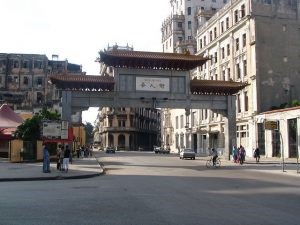
Havana Cuba Chinatown
These Cuban-Chinese began to develop a distinct community. At its pinnacle, in the late 1870s, there were more than 40,000 Chinese in Cuba. In Havana they established “El Barrio Chino” or Chinatown, which spread to 44 square blocks and was once the largest communities of its kind in Latin America. In addition to working in the fields, they opened shops, restaurants, and laundries and worked in factories. A unique fusion Chinese-Cuban cuisine merging Caribbean and Chinese flavors also surfaced.
Residents developed community organizations and social clubs, such as the Casino Chung Wah, founded in 1893. This community association continues to assist the Chinese in Cuba today with education and cultural programs. The Chinese-language weekly, Kwong Wah Po also still publishes in Havana. At the turn of the century, Cuba experienced another wave of Chinese migrants, which included countless coming from California. However, by the 1950s, the Chinese population was declining after the Cuban Revolution.
Kolkata, India
India boasts only one Chinatown, which is located in Kolkata. Chinese people, principally ethnic Hakka from the provinces of Guangdong, Jiangxi and Fujian, have lived in Kolkata for at least 230 years, going back to the time when the city was the capital of the British Empire in India. One of the earliest records of immigration from China can be found in a short treatise from 1820. This record suggests that the first wave of immigration was of Hakkas but does not expand on the professions of these immigrants. According to a later police census, there were 362 Chinese in Calcutta in 1837.

Spice Sellers in Chinatown Market. Photo credit: Steve Browne.
These Chinese immigrants came to work in Kolkata’s busy port, and also became absorbed in manufacturing activities, particularly in tanneries, where they produced leather goods. There was a significant demand, for high quality leather goods in colonial India, which the Chinese were able to fulfill. This profession was off limits to most upper-caste Hindus, who devalued these duties and left the lower class muchis and chamars to take part in this profession. This also allowed the Chinese to monopolize making leather goods.
Although the Chinese population was quite small compared to India’s population as a whole, their contribution to India was still significant. They contributed in the food and beauty department. “Chinese chow” is a popular term for Chinese fried noodles that competed for a place among the popular bhelpuri walas and today, few eating places risk existing unless it also serves Chinese food. Furthermore, the beauty parlours, which were once the sole expertise of Chinese women, now mark almost every corner and street in Indian cities and towns. The Chinese take the credit when it comes to the faces of Indian women. Additionally, licensed opium dens existed, which were run by native Chinese as well as a Cheena Bazaar where contraband was readily available. Opium, however, was not illegal until after India’s Independence from Great Britain in 1947.
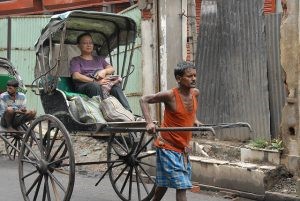
Kolkata Chinatown. Photo credit: Sharon Schneider.
Once reaching heights in the tens of thousands with its own schools, social clubs and newspapers, Kolkata’s Chinese community has now diminished in population to no more than 5,000. Many Chinese in India fled the country in the aftermath of the brief Sino-Indian war of 1962. Many Chinese-Indians were also in military camps and prisons in northern India following that conflict. Those who were not imprisoned were faced with boundary restrictions, and some even had their Indian citizenships revoked. Many of the Chinese saw no future in India and decided to set out to the U.S., Australia and Canada, in hopes of a better life.
Melbourne, Australia
The Victorian Gold Rush brought many young Chinese men from South China to Australia. In 1851, ships filled with gold diggers sailed from Hong Kong to Melbourne. Little Bourke Street was the hub of the Chinese community as more and more Chinese began arriving in Melbourne. This particular location was considered convenient for the immigrants, as it was a staging post for new Chinese immigrants as well as supplies en route to the goldfields.
The Chinese established themselves as storekeepers, importers, furniture-makers, herbalists and in the wholesale fruit and vegetable and restaurant industries. Christian churches were built and Chinese political groups and newspapers were formed next. Other members of the Chinese community who lived and worked elsewhere used Chinatown to congregate with friends.
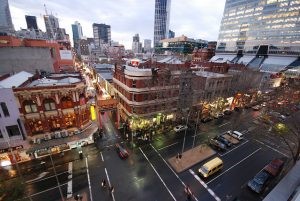
Chinatown Gate Portland. Photo credit: Rosa Say.
It is notable for being the oldest Chinatown in Australia. The boom forged ahead until the introduction of the White Australian Policy in 1901, when the Chinese, along with many non-European immigrants endured hardship under racist rule. However, after the policy was relaxed after World War II, Melbourne’s Chinatown was revived. During the 1970s and 80s, the discriminatory laws that were in place came to an end and immigration began to increase again. Immigrants came from Indochina, Singapore, Malaysia, Taiwan, Hong Kong and the People’s Republic of China.
At the same time, an increasing interest in dining out, and a taste for ethnic variety of cuisine, amongst the non-Chinese population of Melbourne stimulated the growth of over 100 Chinese restaurants in Chinatown. Furthermore, In the 1990s, the large number of overseas Chinese students studying at Melbourne University and RMIT University has brought a new market for Chinese-language cultural businesses and Chinese operated hair and fashion stores. Today, Melbourne’s historic three-story brick buildings remain home to Cantonese restaurants, groceries, herbal medicine shops and a museum that explores the community’s history.
Characteristics Of Chinatown
Architectural Styles
Chinatown is distinguishable by its many unique structures and animal statues. For instance, large red arch entrance structures known in Mandarin as Paifang are often seen when arriving to Chinatown, especially in more metropolitan areas. Often, these archways are complemented by imperial guardian lion statues on either side of the structure, to greet visitors. There are other Chinese architectural styles such as the Chinese Garden of Friendship, present in Sydney Chinatown and the Chinese stone lions at the gate to Victoria, BC Chinatown as well as a variety of other Chinatowns as well. One other example is Mahale Chiniha, the Chinatown in Iran, which contains numerous buildings that were built in the Chinese architectural style.
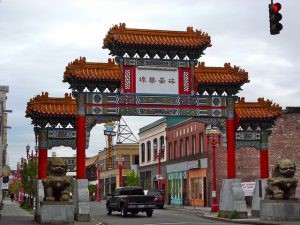
The Paifangs typically have unique inscriptions in Chinese. Historically, these gateways were donated to a particular city as a gift from the Republic of China and People’s Republic of China, or local governments and business organizations. The construction of these red arches is often funded by local financial contributions from the Chinatown community. The size of these structures often vary, some spanning an entire intersection and others are smaller in height and width. The materials used can be anything from wood, masonry to steel.
Language Signs
Chinese language signs are also another characteristic of the multitude of Chinatowns. Many use Chinese calligraphy on storefront signs and utilize bilingual street signs that are in both Chinese and English. In Washington DC’s Chinatown, storefront signs are obligated to have a translation in Chinese characters when the business is located in this district, whether the store is Chinese in nature or not. Local and national American chains, such as Starbucks coffee and CVS drugstores must conform to this rule.
Food
Chinatowns are well known destinations to enjoy ethnic foods. Not simply Chinese cuisine, but Vietnamese, Thai, and Malaysian also have a place in the Chinatown experience. These restaurants serve a purpose as a major economic element as well as a social gathering place. It’s known in many western countries that working in the food business is commonly the only type of employment available to poorer immigrants, especially those who cannot speak the native language of the place they inhabit.
In addition to traditional as well as more stereotypical Chinese restaurants, there are also many large, authentic Cantonese seafood restaurants, restaurants specializing in other varieties of Chinese fare such as Hakka cuisine, Szechuan cuisine, Shanghai cuisine and small restaurants with deli foods.
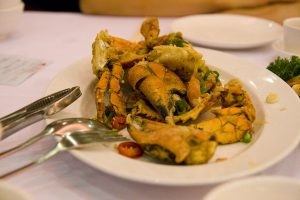
Chinatown Seafood. Photo credit: Howard Walfish.
Cantonese seafood restaurants are distinguished by their dining room layout and ornate designs. They focus on pricey seafood such as, Chinese-style lobsters, crabs, prawns, clams and oysters, which are all kept alive in fish tanks until it is preparation time. These restaurants did very well and became trendy in Hong Kong during the 1960s. Due to their popularity, more of these seafood restaurants began opening overseas. The menu prices are at a much higher level as well as the investment capital required to open and manage one of these restaurants, therefore these restaurants are more common in Chinatowns and satellite communities in developed countries and in fairly affluent Chinese immigrant communities, especially in Australia, Canada and the United States.
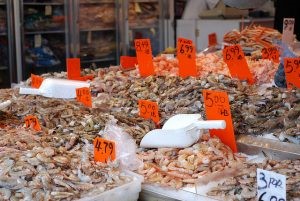
Chinatown seafood. Photo credit: Howard Walfish.
The less expensive food is typically seen in Chinese barbeque deli restaurants, called siu laap, a noodle house or mein ga. These eateries are more unassuming in size and decor than the seafood restaurants. The food is more reasonably priced as well. Many of these types of restaurants can be identified by their displays of whole pre-cooked roasted ducks and suckling pigs hanging in the window. Common foods served here include: wonton noodles, chow fun, Yeung Chow fried rice and rice porridge or congee. These delis also sell barbeque pork, tripe and chicken feet among other delicacies that are not as common to the Western palate.
Shops And Businesses
There are a variety of common goods sold and businesses present in Chinatowns across the world. Grocery stores and seafood markets make up a large chunk of the businesses. Whether it’s sidewalk grocers selling fruits and vegetables or actual indoor markets, there is never a shortage of these supplies. Many items are imported from East Asia and Southeast Asia. Some popular products include Thai jasmine rice, oolong teas, bottles of oyster sauce, Hong Kong soybean beverages, Japanese seaweed as well as Chinese specialties such as black duck eggs, bok choy and water chestnuts. Before the 1970s, many of these products could only be found within the Chinatown territory.
Besides the specialty foods, there are quite a bit of street vendors selling everything from clothes and newspapers to brand name knock offs. There are also stores that focus on Chinese medicine in the form of ginseng and herb shops. Additionally the Buddhist and Taoist religions are of prime importance in Chinese culture. There are stores that sell incense and funeral items, which provide material comfort in the afterlife of the deceased. Small paper replicas of meaningful belongings are also made, such as jewelry and houses. These items are symbolic and are ritually burned in a furnace.
Festivals
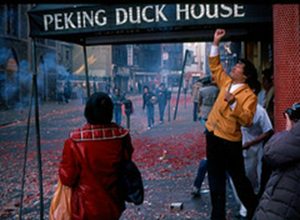
Chinese New Year 1984. Photo credit: John Dunstan.
Each year, in late January or February, Chinese New Year is celebrated immensely in Chinatowns throughout the world. In China, it is also known as the Spring Festival, the literal translation of the modern Chinese name. Chinese New Year celebrations traditionally run from Chinese New Year’s Eve, the last day of the last month of the Chinese calendar, to the Lantern Festival on the 15th day of the first month, making the festival the longest in the Chinese calendar.
Besides the biggest celebration occurring in China, the other top places to celebrate this festive time, include: Vancouver, San Francisco, Los Angeles, Singapore, Sydney, New York and London. From the Golden Dragon Parade in Los Angeles, the dance troupes, fire eaters and lion dancers in Singapore, to the dragon boat races and dragon ball in Sydney, there is much to be celebrated. The source of Chinese New Year is itself centuries old and gains significance because of several myths and traditions. Traditionally, the festival was a time to honor gods as well as ancestors.
Within China, regional customs and traditions concerning the celebration of the Chinese New Year differ widely. Often, the evening preceding Chinese New Year’s Day is an occasion for Chinese families to gather for the annual reunion dinner. It is also traditional for every family to meticulously cleanse the house, in order to sweep away any ill fortune and to make way for good incoming luck. Windows and doors are decorated with red color paper-cuts and couplets with popular themes of “good fortune” or “happiness”, “wealth”, and “longevity.” Other activities include lighting firecrackers and giving money in red paper envelopes.

